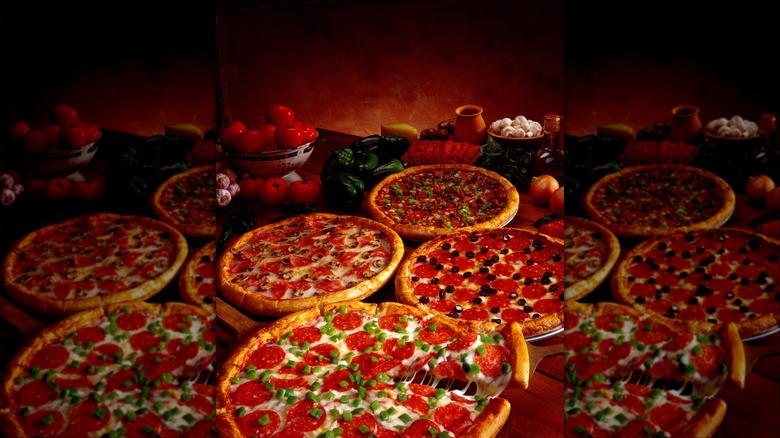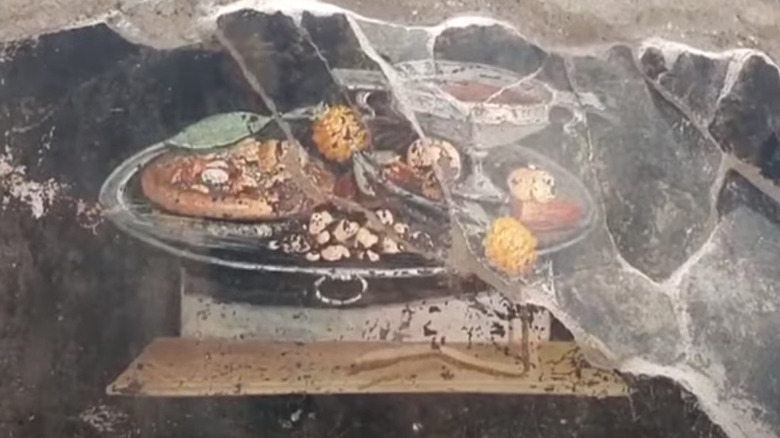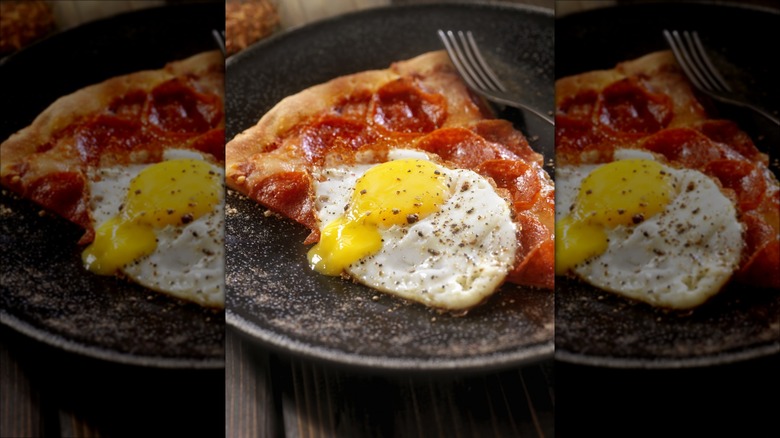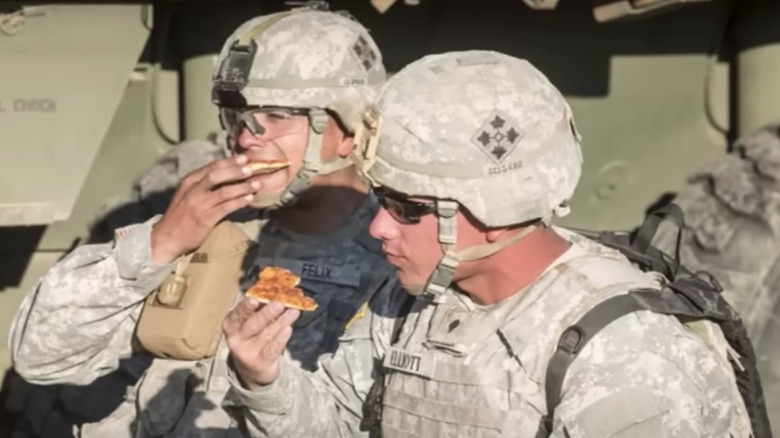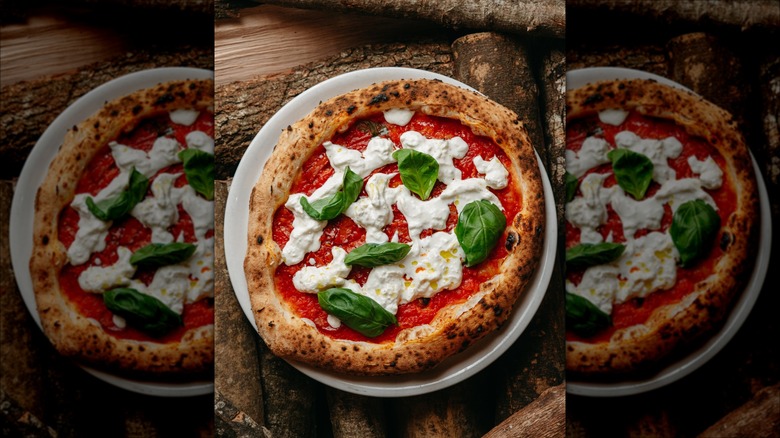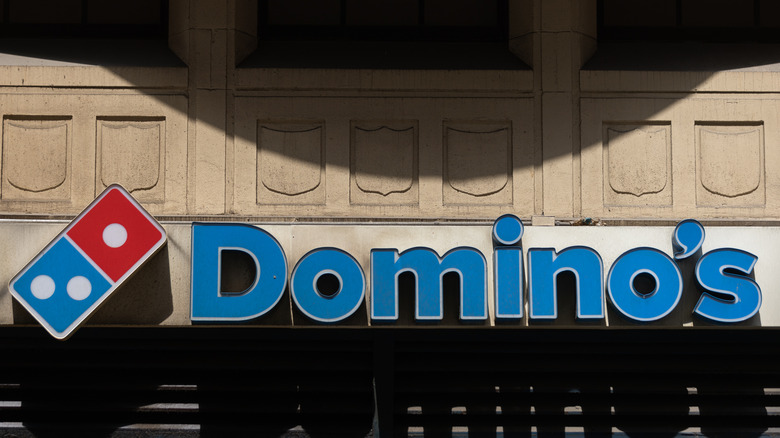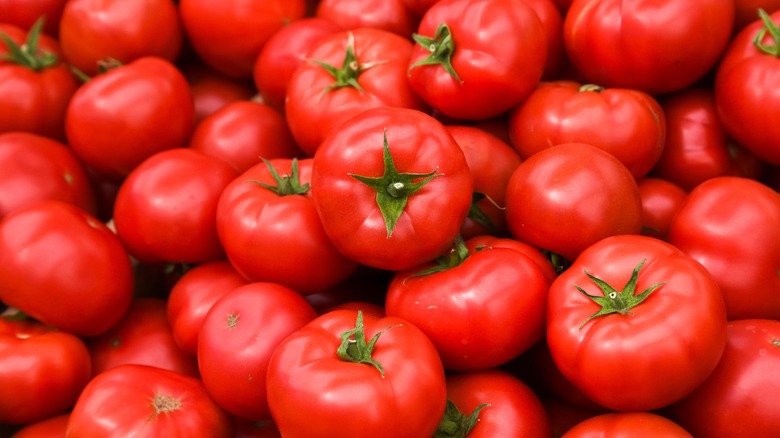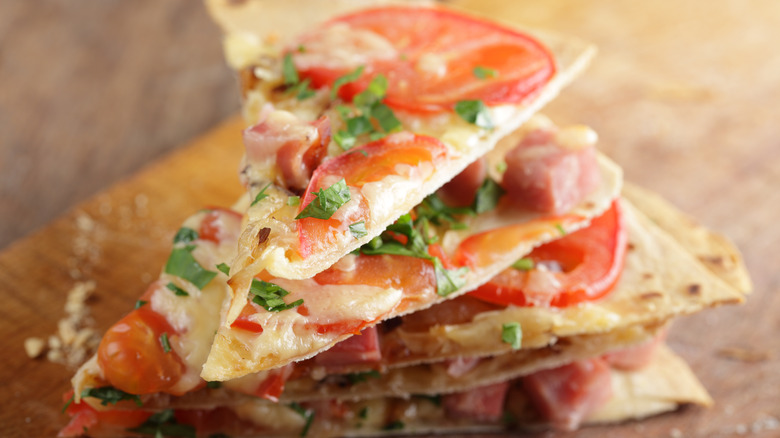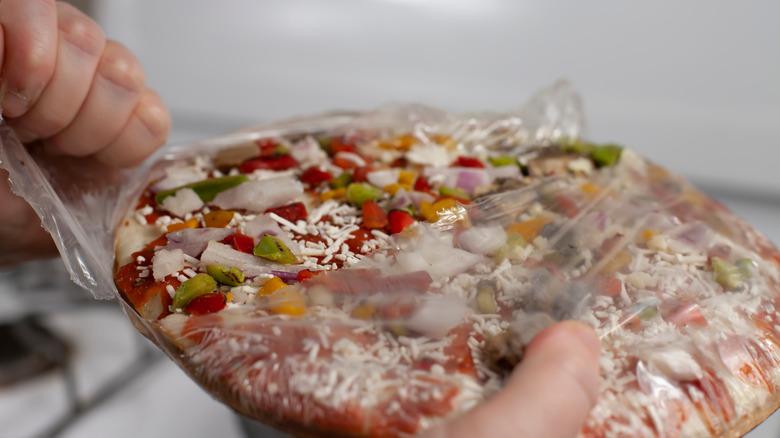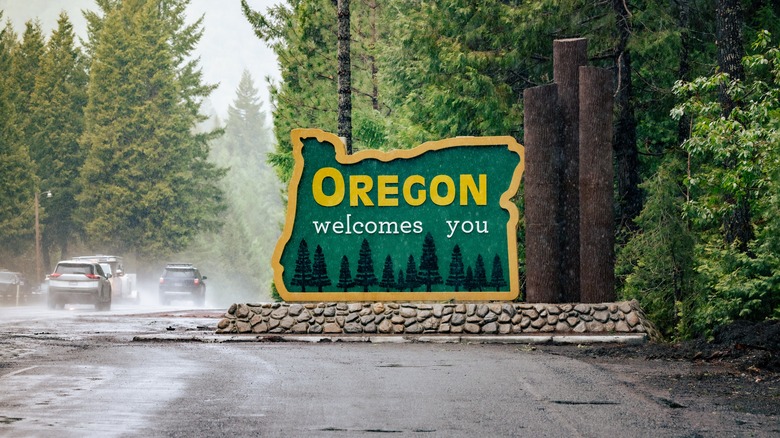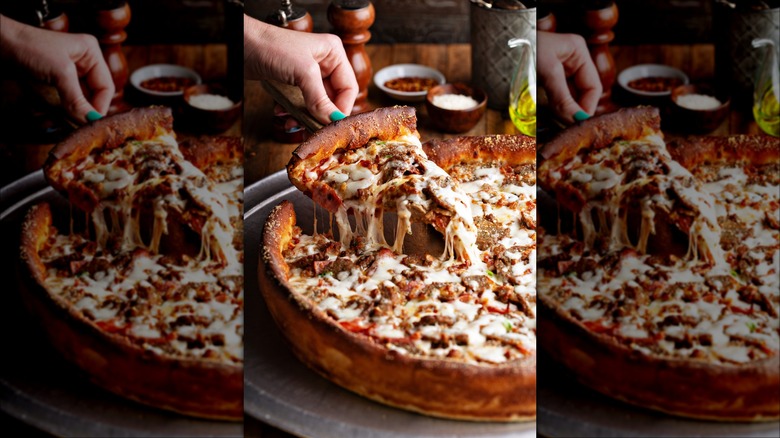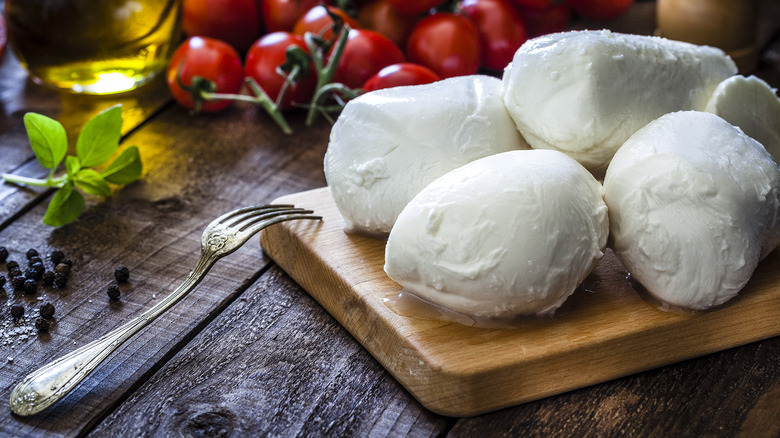12 Facts You Never Knew About Pizza
If you think back to your favorite birthday dinner as a kid, the one in which you got to choose which restaurant everyone in your family ate dinner for the night, it probably included a banquet table piled high with pizza. While birthdays at places like Chuck E. Cheese give us a chance to celebrate our favorite pies one night of the year, National Pizza Month fills our plates with a pie a day for 31 days. One thing is for sure: National Pizza Month makes for one tasty October, no matter how you slice it. But, how much do you really know about the dish that has always been a part of your life?
The following pizza fun facts take us on a journey throughout the ancient world, on side detours around tomatoes, and even in the trenches of the battlefield as we learn about the pizza MREs made especially for members of the American military. All in all, by the time you're done reading these delectable pizza-flavored morsels, you'll have a solid understanding of why pizza grabs us by the taste buds and remains with us for most of our lives.
1. National Pizza Month isn't the only pizza holiday
Not that we need any excuse at all to eat pizza, but apparently, we need a chance to celebrate it, and for that, there is National Pizza Month, which runs the length of October. National Pizza Month came from the pizza-loving brain of Gerry Durnell, the founder of Pizza Today magazine, in 1984. The month-long pizza holiday celebrated the launch of the magazine. It didn't take long for this ode-to-all-things-pizza celebration to gain official footing. In 1987, the US Congress cut the ribbon, or shall we say, the pizza, and christened October the month where we celebrate pizza in all its various forms.
But, we pizza lovers apparently love to celebrate the spicy pie we're kinda addicted to, so for us, one month of dough tossing isn't enough. Fortunately, February gives us National Pizza Day. Pi Day comes to us in March March 14 ( i.e. 3.14), naturally. And, pie lovers appreciate the excuse that the day's wordplay provides. Finally, Cheese Day follows all of this in June. No pizza worth its salt goes out into the world sans cheese, so we celebrate this ooey-gooey concoction for the day by ordering extra cheese on our pie of choice.
2. The history of pizza spans centuries
If you want to start a spirited debate, ask foodies who keep track of food history when pizza was born. Strict traditionalists will answer that pizza as we know it came out of the baker's oven in Naples, Italy, in the late 1800s. By then, many of the traditional toppings for pizza, like mozzarella and tomatoes, had made their way into public consciousness and onto the pieces of flatbread that Neapolitans loved. These precursors to pizza did away with the need for plates and provided a quick meal for the working class.
That is one version of the story of pizza, but recent archaeological findings suggest that before the earthquake in A.D. 79 toppled Pompeii into the sea, Pompeiians were eating the precursor to pizza on the regular. An unearthed fresco in the ruins of Pompeii features flatbread decorated with fruit, pesto, and spices. Some historians scoff at the idea that this is pizza because it doesn't have tomatoes, mozzarella, or any modern toppings.
But the fact is, many of our foods evolve and it's very possible flatbread evolved over the centuries to become pizza. And, it wasn't just the ancient Italians who ate it. People throughout the Mediterranean and beyond ate flatbread, sometimes with toppings. However, there's a good argument for the fruity Pompeiian pizza to be pizza's first-known ancestor. Pompeii and Naples are only about 30 kilometers apart. It seems pizza doesn't fall far from the oven, in a manner of speaking.
3. Surveys show people want pizza as a breakfast item
Who can forget that first weekend away from home, that first weekend of being a college student? Everything is new. The forbidden has been dabbled in. And breakfast? Well, it's a toss-up between chocolate cake and diet Coke or pizza. For pizza lovers, there'd be no toss-up at all, whether it's the first weekend at college or the first Saturday after retirement.
In a study commissioned by Casey's and FleishmanHillard, a full 44% of people would become breakfast eaters if pizza were among the choices (via Bake Magazine). Nearly 60% of people wish for a breakfast pizza to become a thing. And, 53% of adults long for pizza to become a breakfast food with the same street cred as eggs and bacon, per Food & Wine. Many who like pizza for breakfast tout the convenience factor. This includes many parents, who say that not only do their kids like to stop for takeout on the way to school, but also say that if pizza happened to be on the menu of said takeout experience, they would be eating up takeout breakfast pizza right next to their kids.
The verdict is definitely in. Pizza is breakfast time's new "IT" meal, something that college students have known for decades.
4. MRE pizza made by the US military lasts for years
If you plan on stocking your fallout bunker with food that'll last for years on end, then the U.S. Military's MRE (meals, ready to eat) pizza is your friend. Even if you don't exactly have a bunker but just want food that'll last in the pantry for a while, you're in luck if you can get your hands on this field delicacy. Said to last up to three years, it tastes good at room temperature. This is a good thing, given that many MRE's get eaten in conditions that don't exactly qualify as fine dining, or even dining at a Pizza Hut, for that matter.
The inspiration for these food rations comes from conditions where having a kitchen at all would be a luxury. In other words, they're designed to be eaten cold, so they better taste good cold. The pizza comes with pepperoni or turkey pepperoni for those who don't eat pork. They're also surprisingly low in calories. Each slice has only 280 calories. Part of the challenge in developing this meal in a bag came down to containing the moisture in ingredients like the sauce. If it couldn't be managed, mold would follow, ruining a perfectly good field meal for all involved. Fortunately, scientists resolved the issue and pizza is back on the menu for U.S. troops everywhere.
5. It was food for the poor until a queen ordered it
Here's one tasty way to be remembered posthumously. Have a pizza named after you. That's exactly what happened to one of Italy's queens, Margherita of Savoy. According to some accounts, Queen Margherita tapped pizza maker Rafael Esposito to create a specialty pizza just for her. This came after the queen sampled several of Esposito's pizzas, including one with anchovies, before finally settling on a pizza topped with mozzarella, tomatoes, and basil. Esposito had ostensibly chosen the ingredients to honor the colors of the Italian flag: red, white, and green.
It was also a way that Queen Margherita, soon-to-be pizza lover extraordinaire and consort to King Umberto I, could connect with the working poor in her country, for unlike France's wayward (and eventually, headless) queen, Antoinette, Queen Margherita's foray into the world of pizza came from a desire to eat like the less fortunate in her kingdom. Margherita's subjects apparently ate pizza in some form or another more often than they would ever think of eating cake. And, while history is sometimes fuzzy about whether or not Margherita was already married to King Umberto I or soon-to-be when she ate her now-famous pizza, her place in history appears more solid in some ways than her French counterpart. The pizza queen seems to have ended her life not only with her head still attached to her shoulders but also with a pizza named after her that people still eat today.
6. When pizza became popular in America
While Naples, Italy, gets credit for being the birthplace of this delectable pepperoni-covered pie, America basically adopted pizza as its national fast food of choice. However, the conversion of pizza-as-American-food didn't happen overnight. In the U.S., the first licensed pizza place, Lombardi's, sprang up in New York City at the turn of the 20th century, over 100 years after the dish first arrived in the new world by way of Italian immigrants.
But, the topping that gets so much love from Americans — pepperoni — didn't land on pizzas until around the 1950s. Then, with the rise of Domino's Pizza, pepperoni became a topping of choice. In fact, along with the advent of deliverable pizza, America became the place where more people eat the meal than anyplace else on the planet — with nearly $65 billion dollars sold in 2023 alone, per Zippia. American-made Domino's is also the world's biggest pizza chain, making America one pizza-lovin' place.
7. Tomatoes came into the picture in the 1500s
As humans, we tend to think that what we know today is always how things have been. For example, we forget that there was a time before there was the internet, a time before there were cars and a time before pizza had something other than tomato sauce on it. In fact, Italians didn't even know about tomatoes until the 1500s. Once they knew about them, however, they refused to eat them because they believed they were poisonous, so much so that people used to call tomatoes "poison apples."
The fear of tomatoes arose from the fruit's status as a member of the nightshade family of plants. True enough, people during that era often did pass on to the next realm after eating tomatoes, but it wasn't because they were eating nightshade. It was because their dinnerware, which was made of pewter, gave them lead poisoning. The acid in the tomatoes caused the lead to leach and so they became the vehicle that took the lead from their plates to their mouths. Eventually, taste and more solid science did win out. People stopped eating lead and started eating more tomatoes, instead. And, by the late 1800s, enough people were eating tomatoes to make them a viable topping option for the first pizzas to come out of Naples.
8. The average person eats five pieces of pizza in one sitting
According to a poll commissioned by Amazon Fresh and conducted with the help of OnePoll, the average pizza eater in the U.S. eats more than five slices of pizza in one sitting. Given that most Americans eat pizza, on average, three times a month, that adds up to 180 slices of pizza per year.
This factoid may make us Americans seem a little pizza crazy, but apparently, there is sound science behind why we feel inclined to eat five pieces of pizza in a sitting. Pizza toppings like tomatoes, cheese, and meats contain glutamate – the same glutamate that's in MSG. While most people think that this flavor enhancer only comes in a bottle, the fact is, MSG finds its way into many foods naturally, including many of those commonly found on top of pizzas. The addition of MSG to a recipe strengthens the essence of certain spices, like salt, making biting into pizza a bit like a savory party on the tongue.
Aside from this, cheese offers another whammy: casein. In a study conducted by Schulte EM, Avena NM et al., this tasty chemical was shown to trigger the same receptors in the brain as opioids. In other words, there's stuff in cheese that can lead to addiction, in the same way opioids do, only to a lesser degree.
9. Americans prefer take-and-bake to restaurant pizza
We love eating pizza, and it's all the better if we can eat it at our own tables and on our own plates. According to the OnePoll/Amazon Fresh poll, a full 30% of pizza lovers in the U.S. like their frozen or take-and-bake pizzas better than they do the pizza they eat in a restaurant. In all fairness, though, the numbers are pretty close, with 26% of Americans preferring to eat at their pizzeria of choice. As for delivery, that's in a distant third place, with only 16% of respondents saying that they like to have it dropped off right at their front door.
These preferences appear to come as a leftover from the COVID-19 pandemic, when 43% of Americans began consuming take-and-bake or frozen pizza at least once a week, per a report done by Technomic's Pizza Trend Report (via Food Business News). Additionally, not only did people in 2020 like the ability to personalize their orders, but they also wanted food that wasn't handled by as many fingers. Take-and-bake and frozen pizzas ticked off both of those boxes.
While it appears the stay-at-home days of the pandemic are over, some of the habits we formed during that time seemingly remain. Pizza eaters just like flavor options that are also kind to their wallets, and take-and-bake and frozen pizzas are one way they can be mindful of those factors.
10. Oregon has the most expensive pizza in the US
If you're going for budget pizza, one option is to order a plain cheese pizza because, as any experienced pizza eater will know, each item costs extra. However, if you're in Oregon you may just want to avoid any extra toppings because a large cheese pizza in the Beaver State isn't cheap. At nearly $27 a pie, pizzerias in Oregon charge the most for a cheese pizza anywhere in the U.S., according to a study by the Slice app poll (via Market Watch).
On the other hand, if you're ordering cheese pizza in Oklahoma, go ahead and order olives and pepperoni, too. With cheese pizza coming in at under $13, the extras won't break your budget. Of course, even a $27 pizza seems like a small change compared to $2700, which is the most expensive commercially available pizza you can buy. According to the Guinness World Records, black squid ink dough and other delicacies spike the cost.
11. There's such a thing as a perfect pizza
If there is one thing we learned from the recent Amazon Fresh poll, it's that there is a perfect pizza prototype baking in our foodie fantasies. It's the stuff that national pizza commercials are made of: round, thick crust encircling the pie and toppings galore. And speaking of toppings, tomato sauce, and mozzarella cheese play a big role in this fantasy-perfect pizza. The other toppings of choice are sausage, pepperoni, mushrooms, and Parmesan cheese.
The reality of this perfect pizza is that it is a composite of percentages based on the preferences of the majority of the people answering questions about their perfect pizza. More specifically, we learned from the poll that 65% of people in the U.S. preferred a round-shaped pizza, whereas, in some states, like Idaho, Georgia, and New York, square pizzas make the heart sing. 32% of the people polled wanted the thick, bready crust. Nearly ⅔, or 61%, of people liked tomato sauce on top of their pizza, while 59%, 51%, 42%, and 37% liked mozzarella, pepperoni, sausage, mushrooms, and Parmesan respectively, with mushrooms and Parm tying at 37%. Other topping deviants include places like Texas where ranch on pizza is a big thing. And some states, like Tennessee and South Dakota, opt for thin crusts instead the thick, bready ones.
12. The rise in mozzarella consumption correlates with pizza's popularity
It's a variation on the age-old question. Which came first, the cheese or the pizza? This argument could go on ad infinitum due the to fact that cheese and some form of pizza, or at least its precursor, flatbread, have been around for centuries. However, for our purposes, we'll concentrate on caves full of cheese in the Midwest that began filling up in the 1970s.
Bear with us here. This isn't as tangential as it seems. Apparently, in an effort to give farmers a leg-up, U.S. President Jimmy Carter spearheaded a dairy subsidies program that stashed all the surplus cheese that farmers could make in a cave in Missouri. It was hoped that, if the surplus dairy produced couldn't be consumed, then at least it could be stashed in a form that was more stable than milk, which brings us to caves full of cheese of pretty much every sort, including that pizza staple, mozzarella.
But, the dairy subsidies program really got milked when food companies, including pizza chains, teamed up with the government entity The National Dairy Promotion Board, which gave life to both the celebrity-mustache-decorated "Got Milk" ad campaign and Domino's seven-cheese pizza. All of this took place against the backdrop of the Great Pizza Wars of the 1990s. It's probably no surprise, then, that Little Cesear's Big! Big Cheese pizza and Pizza Hut's copycat, sort of, the 12" X 24" pizza, the Bigfoot, found popularity just then.

